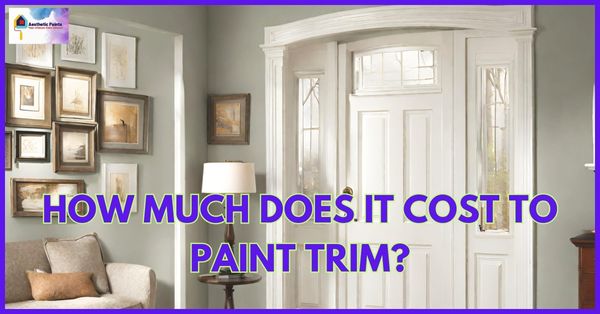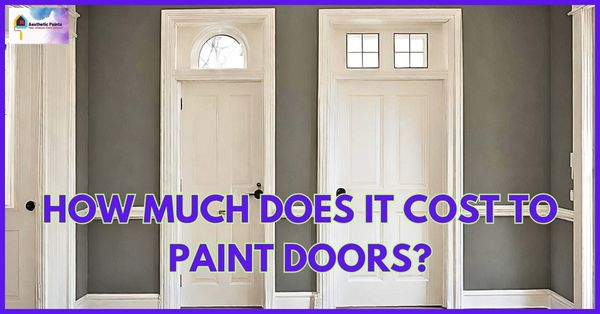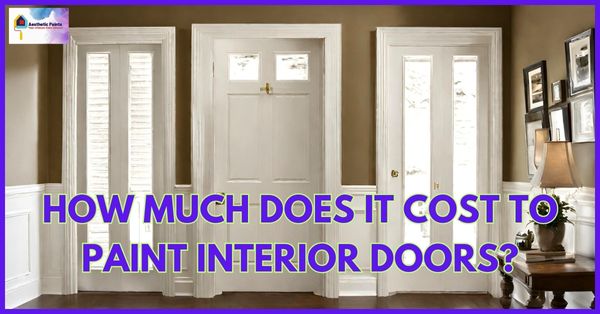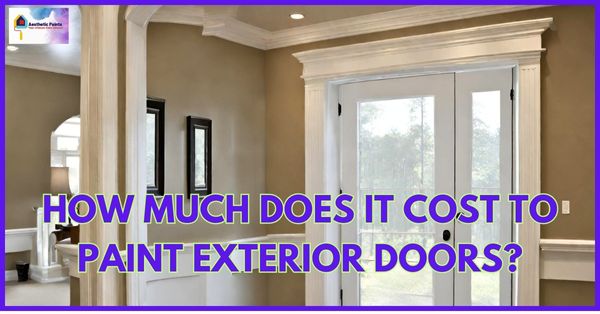Painting your doors and trim is one of the ideal decisions to give your house’s interior and exterior a fresh appearance. Painting your trims and doors can also save you from damage and enhance your property’s worth. However, you may want to know how much does it cost to paint trim and doors before you dip the brush into the paint.
Painting trim typically costs between $1 to $6 for each linear foot. Each door will normally cost between $50 and $300 to paint. This cost includes all supplies costs as well as labor costs. However, this cost can vary a lot depending on several factors like a door or trim type, size, supplies quality, as well as your location.
This article is going to outline the costs involved in painting your doors and trim. It will assist you in creating an appropriate budget for this important home renovation project.
Let’s explore the complexities of painting expenses to assist you in making a wise decision.
Why Should You Paint Trim and Doors?
Painting the trim and doors of your house enhances its overall aesthetic appeal while bringing attention to architectural features with vibrant, modern colors. A quality paint job considerably raises a home’s value since it shows thorough maintenance and attention to detail.
In addition, fresh paint functions as a screen, protecting these surfaces from deterioration caused by the elements and wear over time.
Additionally, the paint may hide ugly dents, marks, and other minor flaws to create a cleaner, more harmonious appearance.
Periodic painting helps preserve structural integrity while promoting a lively and pleasant living environment. As a result, homeowners who choose to engage in an excellent paint project do so for reasons other than aesthetics.
How Much Does it Cost to Paint Trim and Doors?
The ultimate cost of the paintwork project of trims and doors can vary a lot depending on several aspects. Here, I’ll describe the painting cost of your trims and doors separately, which will help you understand the estimated cost.
So, let’s get started:
How much does it cost to paint Trims?
The pricing for interior trim painting is contingent on a multitude of factors. Moreover, this cost can vary a lot from interior trims to exterior trims. Now, I’ll explore the painting cost for both the interior as well as exterior trims of your house.

Cost to Paint Interior Trim
The cost of painting interior trim depends on several things, including paint type, the size of the trim, the amount of surface preparation needed, and the type of material used for the trim. While the typical cost of painting inside trim can range from $1 to $5 for each linear foot, the actual cost will be greatly influenced by the size of your house.
The cost of the project typically includes labor, supplies, and essential preparation. The total number of linear feet of trim in a house’s interior varies according to size. Nevertheless, the typical price for painting inside trim might range from $500 to $2000.
Cost of Painting Interior Trim based on Trim Types
In the below table, I’ll describe the painting cost of interior trims based on trim types separately, which will help you understand the estimated cost.
| Type | Cost per Linear Foot |
|---|---|
| Baseboard | $1 – $4 |
| Casing | $1 – $4 |
| Crown Molding | $1 – $4 |
| Chair Rail Molding | $1 – $5 |
| Picture Rail Molding | $1 – $5 |
| Wall Frame Molding | $1 – $5 |
Cost to Paint Exterior Trim
Painting the exterior trim of a home tends to be on the higher side of the cost spectrum. Exterior trim painting typically costs $1 to $6 per linear foot, with an average cost between $800 and $2,500. It’s worth noting that when tackling hard-to-reach areas like second-story sections, dormers, or soffits, there might be an additional cost of $1 to $2 per linear foot due to the increased complexity of the task.
Since exterior paint needs to be able to survive frequent UV rays, dampness, wind, and harsh temperatures, it often costs a little more than inside paint. Professional painters also take into account the risks of painting at heights, longer workdays, and climbing and descending ladders. Intricate or second-floor sections will incur higher hourly rates or fixed prices.
Cost Of Painting Exterior Trim by Trim Types
In the below table, I’ll describe the painting cost of exterior trim based on trim types separately, which will help you understand the estimated cost.
| Type | Cost per Linear Foot |
|---|---|
| Door | $1 – $5 |
| Dormers | $2 – $5 |
| Downspouts | $4 – $6 |
| Eaves | $3- $6 |
| Fascia and Soffit | $5 – $6 |
| Gables | $5 – $6 |
| Fascia and Soffit | $1 – $5 |
How much does it cost to paint Doors?

The cost associated with painting doors is a fluid figure shaped by a tapestry of variables. Prior to diving into the project, it is advisable to delve into thorough research and perhaps solicit quotations from a spectrum of sources.
Let’s explore the cost of painting interior and exterior doors.
| Included Costs | For Interior Door | For Exterior Door |
|---|---|---|
| Paint | $30-$50 | $40-$80 |
| Primer | $20-$40 | $30-$50 |
| Other Supplies | $10-$20 | $20-$40 |
| Labor Cost [2 Hours] | $40-$100 | $60-$150 |
| Total Average Cost | $70-$200 | $100-$300 |
Cost to Paint Interior Doors
The cost of painting an interior door is associated with painting supplies cost like paint cost, primer cost, and supplies cost, as well as the cost of hiring labor. In general, painting an interior door will cost you around $70 to $200. However, you can save around $30 to $70 by painting your interior doors yourself.

Cost to Paint Exterior Doors
Painting exterior doors will cost you a bit more than interior doors. This is because exterior door paints are relatively more expensive than indoor door paints, and exterior doors need a bit more preparation. The cost of painting your exterior doors can range between $100 to $300 per door. However, you can save some cost by painting the door yourself.

Labor Costs to Paint Trim and Door
Professional painters often offer prices that include the labor time required for the project, based on an hourly rate or a flat cost. For interior and exterior trim painting, you should average $20 to $75 per hour. It’s vital to keep in mind that the project’s overall length might vary considerably; it normally lasts between five and 25 hours.
This diversity is influenced by various variables, such as the level of preparation needed, the accessibility of the trim, the total size of the trim surfaces, and the quantity of paint coats necessary to attain the desired finish. It is thus essential to go through these details with your selected painter to get a precise quote that is relevant to your painting project.
The Frequently Asked Questions (FAQs)
How do you prepare trim for painting?
To prepare your trim for painting, you should eliminate any remaining paint or smooth it down. Filling cracks or imperfections in the wood using wood putty is advised. Utilize a primer to stop tannins from seeping through untreated wood or other flaws and defects from detracting from the paint.
How much does it cost to eliminate paint from the trim?
Experts offer paint removal services for trim molding at rates ranging from $1.50 to $5 per square foot. However, if you opt for a do-it-yourself approach, you can undertake the paint removal using a combination of a sander and paint stripper, incurring costs within the range of $12 to $20.
What paint do I use on the trim and Doors?
There are different types of paints available in the market. However, water-based acrylic paints are the best option for painting doors and trims. Moreover, you can also use oil-based paints for painting exterior doors and frames because these paints offer highly durable and long-lasting coating.
What Paint Finish is best for Doors and Trims?
To make doors and trim stand out, certain homeowners and interior designers choose semi-gloss as well as high-gloss paint. However, it’s typical to choose eggshell or even satin to match the shine of your space in most situations. Additionally, use a flatter paint to cover any flaws in the door and trim.
Is painting the door and trim worth it?
Yes, painting your home’s doors and trim will revitalize the atmosphere while also increasing its aesthetic and financial worth. Surfaces are protected against abrasion, giving a longer lifespan and continued integrity. A new coat may cover flaws and provide a cleaner, more contemporary appearance.






